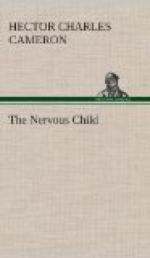The muscular system and the bones are commonly also involved, so that rickety changes are often found in these infantile and watery children. In early childhood the processes of calcification and decalcification proceed side by side and with great rapidity, and in health there is always a balance on the side of the constructive process. In the children whom we are now considering, saturated as they are, from time to time, with the toxins resulting from repeated infection, ossification may be so interfered with as to cause softening and bending, with the evolution of a state of rickets. Between bone and muscle, too, we find a close relationship. We do not find powerful muscles with softened bone, nor flabby muscle with rigid and well-formed bone.
In the nervous system, the conditions are somewhat different. In skin, in bone, and in muscle new cell elements are constantly being formed, and the life of the individual cell is relatively short. In the nervous system, on the other hand, the individual cells are long lived. Their life-history may even be coterminous with that of the individual, and if destroyed they are not replaced. Nevertheless, they do not escape undamaged in the general disturbance. In a deprivation of calcium we have, in all probability, the explanation of the increased irritability of peripheral nerves and of the tendency to convulsive seizures of all sorts which is a common accompaniment of the condition. Convulsions, laryngismus stridulus, tetany, or carpopedal spasm are all frequently met with. In crying, the children hold their breath to the point of producing extreme cyanosis, ending, as the spasm relaxes, with a crowing inspiration, which resembles and yet differs in tone from both the whoop of whooping-cough and the crowing inspiration of croup.




